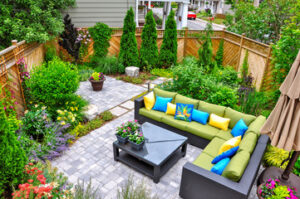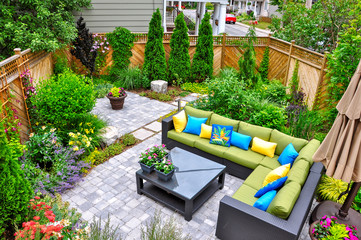A well-designed and executed Hardscaping project can add value to your property. Patios, landscaped walkways, retaining walls, and water features are in high demand among potential home buyers.
Hardscapes require less maintenance than plants. Instead of mowing the lawn and trimming bushes, you’ll spend time relaxing and enjoying your beautiful landscaping.
Patios are one of the most popular hardscape features and they’re great for bringing people together outdoors. They also add a beautiful focal point that increases your property value and curb appeal. Patios can be built with a variety of materials such as pavers, cement, brick or wood. A professional can advise you on the best materials for your home and budget.
When it comes to laying out your patio, a well-prepared foundation is key to a successful project. This includes digging to the proper depth, removing organic material and compacting thoroughly before adding the new layer of gravel or sand. This step helps ensure that your hardscape structures will last longer and stay in place, according to Optima Landscape.
Different types of hardscapes require different levels of maintenance. For example, while brick structures are known for their durability, they’re more difficult to maintain than natural stone and wood structures. Depending on the type of patio you desire, you might want to consider the amount of upkeep and maintenance required before making your final decision.
While it may be tempting to opt for a completely hardscaped outdoor space, it’s important to include plenty of plant life as well. This can be particularly beneficial for homeowners in warm, arid areas. For instance, Southwesterners sometimes have to focus on hardscapes as a matter of necessity due to the strong sun and lack of water.
A well-designed hardscape can increase your home’s curb appeal and make it easier to sell when it’s time to move on. However, it’s vital to consult with a professional before starting any projects that may be too large or complex. This can help you avoid costly mistakes and keep your project on track.
Walkways
In addition to the aforementioned patios, hardscapes can also include walkways that create paths throughout your yard. These are not just functional – they can also be very stylish and add distinction to your landscape design. With a wide range of materials available, Liberty Township hardscaping experts can create pathways and trails that both beckon you to wander as well as provide a clear and defined path from one point to another.
Whether you want a simple brick walkway to lead guests from the driveway to the front door or a meandering pathway through your gardens, these are a great way to showcase your creative side while providing a reliable surface to walk on. Using pavers, flagstones, gravel with wood or brick components, concrete and natural stepping stones, these are one of the most popular ways to give your yard a hardscape.
These are also a good way to avoid unnecessary water usage, as they trap rainwater that can then be used for irrigation in your garden. This will not only reduce the amount of water you use, but it will also help with preserving and protecting our limited freshwater resources.
While your lawn and flower beds may be beautiful, they can sometimes fall flat on the eyes of people passing by from the road or a nearby sidewalk. Adding a hardscape can help draw out their latent beauty, thereby making your entire property look like it was designed with intent and purpose. Adding a retaining wall to your garden, a stone staircase to the front of your house, a pagoda for an oriental touch or even just a few carved stones to accent your landscape can make all the difference in how well you come across from afar.
Retaining Walls
Retaining walls are a form of hardscaping that is used to prevent soil erosion. They can also be used to create usable land by leveling slopes. They can be built in a variety of different styles and materials to suit the design and aesthetic of your landscape. They can also serve as a safety feature by helping to support driveways, stairs, and other structures on your property that may be at risk of shifting or falling off of a steep slope.
Retaining wall construction requires careful planning to ensure proper drainage and safety. These structures are designed to resist lateral earth pressure by placing compacted soil between layers of reinforcement material and anchoring them with a concrete-facing panel. The structural integrity of a retaining wall is based on its design, height, and materials. There are several types of retaining walls, including gravity, mechanically stabilized earth (MSE), crib, and hybrid walls.
Concrete, pavers, and brick are popular materials for constructing retaining walls. These hardscape features provide a beautiful, durable, and long-lasting alternative to traditional lawns and flower beds. They can also be used to create unique landscape designs and add value to your home or business.
Adding a retaining wall to your property can help correct slopes, improve drainage, and make it easier for you to maintain your yard. They can also reduce maintenance by preventing soil erosion and protecting structures on your property like foundations, roads, and sidewalks from shifting or falling off of a steep slope. Depending on the style and material you choose, a retaining wall can also add a sense of visual interest to your landscaping and become an attractive focal point for any outdoor space.
Water Features
Adding water features like waterfalls or fountains to your yard not only adds beauty, but it also helps conserve water and is a great way to help keep the plants in your garden looking good. It also provides a place for you to relax and enjoy your yard. Plus, water features require less maintenance than the plant life in your yard. This is because they don’t need to be watered or weeded as often.
The most common water features are rivers, aquifers, lakes, and puddles. Several important aspects of these features have not been fully characterized or represented in existing hydrological ontologies. The main gap is related to the relationship between containment and support.
For example, a contained water feature can be both contained and supported by a solid material container (e.g. a river channel), while a supported water feature can be neither contained nor supported (e.g. a leaky aquifer).
Another gap is the representation of sensor measurements that are associated with the most popular water features, such as the rate of flow and chemistry, surface and subsurface water height, and overflow. Such sensors are not typically hosted by the features themselves, but rather by environmental perdurants (e.g. the flow of water) or by other components that interact with the feature, such as the ground and/or the atmosphere.
To address these gaps, we formally characterize water features as physical object wholes that have a persistent variable part, i.e., the amount of water matter. The resulting characterization has implications for both the notion of a whole and for the categorizations of parts that constitute it. The characterization also yields an enhanced notion of whole-part relation and a formal representation.
Lighting
Most homes have some kind of lighting for their patios and entrances. But it’s not always pretty, and it certainly isn’t enough to make those spaces livable after dark. Other hardscape features that require lighting include outdoor kitchens, fire pits, and fireplaces. Lighting can also be added to walkways and paved paths so they’re safer and easier to use at night.
It’s important to plan out lighting with your hardscape contractors before starting any construction. This way, the lights can be planned out at the same time as the hardscapes are being installed and the contractor will know where to place them, making for a much smoother installation. If you are a homeowner and want to install your own lights, there are many different fixtures available that can be used on hardscapes. For instance, DEKOR’s Hardscape Wall Light is designed to be installed on stone, masonry or concrete walls and can be routed through the top lip of the wall.
The right landscape lighting can really take your hardscapes to the next level. It can highlight the design elements of a patio or staircase and draw attention to them, helping to create a focal point and add visual appeal to your landscape. It can also improve safety and security by illuminating pathways and driveways to reduce the risk of accidents, and it can extend usability by allowing you to enjoy your Belgard Brick Oven or synthetic turf lawn well into the evening. For the best results, choose a fixture that matches or complements your hardscape. And don’t forget to add a few low-profile accent lights for those hardscapes that aren’t necessarily the focal point, such as walls or stairs.
